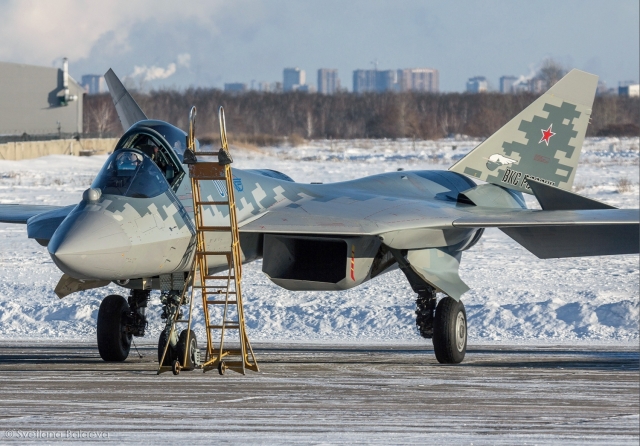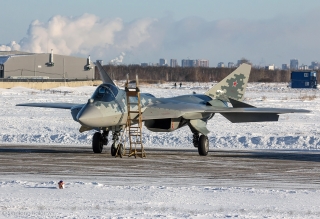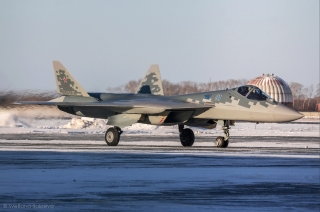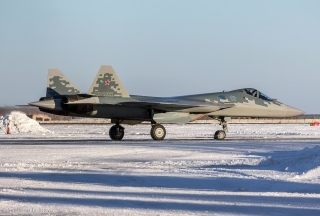Series Su-57 flies to Akhtubinsk
On 25 December 2020, the second of the two production models of the fifth generation Su-57 (T.50S-2, serial 51002, Bort No. 01 Blue) has been photographed by Russian spotters during the refuelling stop at the Novosibirsk Tolmachevo airport.
The aircraft was conducting a flight from the KnAAZ plant (Komsomolsky-on-Amur Aviation Plant named after Y.A.Gagarin, a branch of PJSC Company Sukhoi, part of PJSC UAC State Corporation Rostec), to the final destination which was Akhtubinsk.
As a reminder, in August 2018 the Ministry of Defence of the Russian Federation and PJSC Company Sukhoi signed a contract for the supply of first two Su-57 fighters in the T.50S initial series configuration sporting the Izd.117 first stage engines. These two aircraft were to be delivered in 2019 (T.50S-1 example) and 2020 (T.50S-2). In June 2019, a follow-up contract has been signed for the supply of 76 series build Su-57 FELONs (including the first two contracted aircraft) with the deadline for the execution by the end of 2027.
The original first production Su-57 (T.50S-1, serial 51001, Bort No. 01 Blue) made its first flight in Komsomolsk-on-Amur in early December 2019 and was scheduled to be handed over to the Russian MoD on 27 December 2019. Unfortunately, this example was destroyed in an accident on 24 December 2019, in the final stage of factory tests, due to a failure in the aircraft control system. This incident led to some uproar and several personal changes within the management of the PJSC Company Sukhoi, especially due to the fact that the company will need to compensate for the loss and supply a replacement aircraft at their own expense. Nevertheless, the incident has turned out to be annoying, but not critical, it has finally lead to some adjustments in the timing of the production of aircraft for the next year, as the assembly output will have to be increased accordingly.
The „second first“ production FELON has been finalized in the assembly shop No.45 of the KnAAZ plant in September 2020 and the flight tests began in Komsomolsk-on-Amur in October 2020. According to the expectations, this aircraft also received the bort number 01 Blue, this time with the blue symbol of the 929 GLITs MO RF in Akhtubinsk (929th State Flight Test Center of the MoD of the Russian Federation named after V.P. Chkalov).
Earlier, it was reported that KnAAZ had problems with logistics of the series examples as there were no separate zones specifically for this type and the manufacturing needed to be carried out in different parts of the assembly shop. But after the representatives of the Ministry of Defence began to impose very high requirements on the assembly and production culture, the No.45 shop underwent a major overhaul in order to meet the new quality standards.
In recent photographs of the assembly process of the second machine it is noticeable how much the level of build quality has improved. Compared to the early prototypes there are practically no gaps visible on the series examples, the fuselage is very smooth and sawtooth edges have appeared in the area of technological compartments and the refueling system. How this all improves the overall Radar cross-section (RCS) of the fighter remains to be seen, but the figures circulating on the web (0.42-0.44 m2 overall aspect RCS of the prototypes), even if not quite on par with the F-35, already fit reasonably well with the announced low-visibility concept.
The T.50S configuration sports the complete sensor suites – the NIIP Sh-121 radar suite consisting of N036 primary X-band AESA array, two lateral N036B X-band arrays and two N036L L-band arrays installed in the leading edge flaps, as well as the UOMZ 101KS Atoll electro-optical suite consisting of 101KS-V IRST sensor, two 101KS-O laser turrets, 101KS-U ultraviolet MAWS sensors, 101KS-P low altitude sensor located in the leading tip of the port lateral missile bay, as well as the 101KS-N targeting pod (although not carried during the said flight).
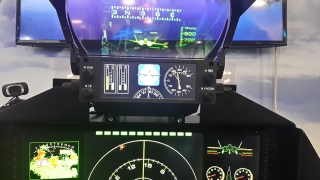 There is no exact information about the cockpit layout of this aircraft but it can be assumed that the series examples have the RPKB Ramenskoye prototype layout with MFI-50 and ISRP-50 displays replaced by an entirely new cockpit suite with fully integrated touch screen system, developed by the PJSC Elkus, a St. Petersburg-based company noted for the docking panels used on the ISS. The heart of the new dashboard is the MMFT-25, a 25-inch solid information field in the 8:3 screen format with 3200x1200 pixel resolution which can be used as a smartphone touchscreen.
There is no exact information about the cockpit layout of this aircraft but it can be assumed that the series examples have the RPKB Ramenskoye prototype layout with MFI-50 and ISRP-50 displays replaced by an entirely new cockpit suite with fully integrated touch screen system, developed by the PJSC Elkus, a St. Petersburg-based company noted for the docking panels used on the ISS. The heart of the new dashboard is the MMFT-25, a 25-inch solid information field in the 8:3 screen format with 3200x1200 pixel resolution which can be used as a smartphone touchscreen.
As noted from the photos on the MAKS 2019, the ShKAI HUD has, too, been replaced by a new IKC type which is able to combine a wide-angle HUD with two additional ELT15S-1500 transparent lateral displays located at the edges of the panel within the pilot's field of view. We will gladly post more information about the final layout after it becomes available.


